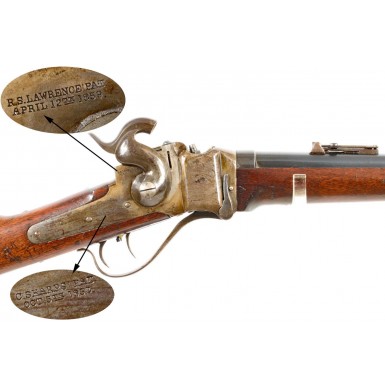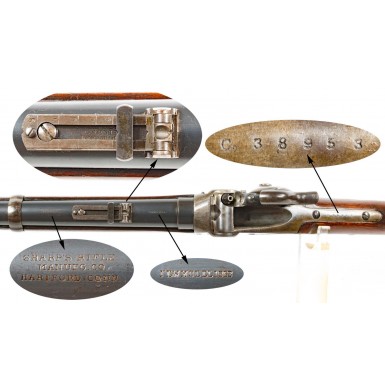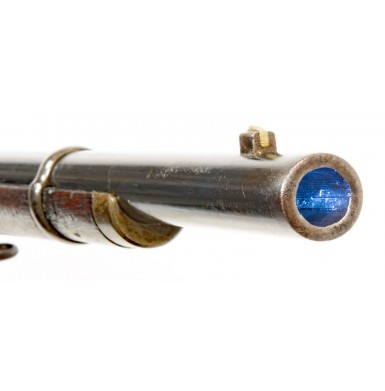The Sharps family of rifles and carbines are probably the most recognizable of all the breech loading firearms to be proven successful during the course of the American Civil War. Christian Sharps is probably responsible for designing the most successful and recognizable family of breechloading arms of the 19th century. Sharps’ early training in the field of firearms had occurred at the Harpers Ferry Arsenal in Virginia, where he went to work in 1830 under the supervision of gun designer John Hall, who as a pioneer of the “American System of Manufacture”; assembly-line manufacturing using interchangeable parts produced to strict tolerances. Sharps worked at Harpers Ferry for over a decade, learning the not only the arms making trade, but the early concepts of assembly line production as well.
In 1848, Sharps received his first patent for a breech-loading carbine. The first Sharps patent firearms were produced by A.S. Nippes of Mill Creek, PA in 1849 and 1850. By 1851, Sharps formed the Sharps Rifle Manufacturing Company in Hartford, CT. As the company was not yet ready to produce arms, Sharps entered into an agreement with Robbins & Lawrence of Windsor, VT to manufacture his arms. By 1852, R.S. Lawrence (formerly of Robbins & Lawrence) moved to Hartford and became the master armorer of the Sharps Rifle Company. Over the next seven years, Sharps produced a variety of carbines and rifles of various patterns, with each new pattern an attempt to improve upon his earlier designs. However, all the future success of the business was without the namesake of the company at its helm. Rather, Christian Sharps established a new business under the name C. Sharps & Company in Philadelphia in 1854, after various issues with Lawrence and others at the original company.
During the 1850s, several thousand arms were produced by the Sharps Rifle Manufacturing Company both for various small US government contracts and for sale to the general public. The Sharps Rifle Company really struck gold with the introduction of their “New Model” 1859 series of breechloading percussion carbines and rifles, which were subsequently improved upon as the “New Model” 1863. During the Civil War, the Sharps Rifle Company produced thousands of carbines and rifles for the US government with more than 77,000 of their carbines being purchased for use by the US military! While the Spencer might have shot quicker with its repeating action and seven-round magazine, no breechloading carbine or rifle was more beloved for its sturdy reliability in the field and proven accuracy than the Sharps. It was for this reason that the New Model 1859 was selected by Colonel Hiram Berdan to arm his 1st and 2nd Regiments of US Sharpshooters.
By the end of the American Civil War it had become clear that the percussion era was also reaching its end and that self-contained metallic cartridges were the future of firearms designs. Few percussion rifle designs were as readily adaptable to the metallic cartridge as was the Sharps. After the war, the Sharps designs were easily modified for use with metallic cartridges, especially powerful, long-range cartridges, and in many ways the M1874 rifle in 45-70 and larger calibers was responsible for the taming of the American West, due their devastating effectiveness against the North American Bison.
The primary Sharps models to see Civil War use were the New Model 1859and New Model 1863rifles and carbines. Approximately 6,150 New Model 1863 Rifles were produced and delivered to the US government for use by the US military. The New Model 1863 was the pinnacle of the Sharps Rifle Company’s beech-loading, percussion-ignition military rifle designs. The rifles featured a 30” round barrel, secured by three spring-retained barrel bands and a combination front sight / bayonet lug that allowed a socket bayonet to be secured to the rifle. An adjustable rear sight of Lawrence’s design, graduated to 800-yards, allowed the rifles to be used effectively at longer ranges than conventional muskets. Like the New Model 1859 version before them the NM1863s had blued barrels and color case hardened receivers and furniture. These rifles were produced in the C, 30,000 to C, 40,000 serial number range (Sharps used the “C” designation to indicate serial numbers in the 100,000 range). Sharps rifles (both NM1859 and NM1863) were issued to a number of US regiments, other than the 1st & 2nd US Sharpshooters. The infantry regiments included the 1st, 2nd, 4th, 6th-8th, 11th, 13th & 14th Connecticut, 66th & 113th Illinois, 20th Indiana, 11th, 12th Kentucky, 3rd, 5th & 16th Michigan, 15th Massachusetts, 1st & 8th Minnesota, 26th & 27th Missouri, 2nd & 3rd New Hampshire, 30th New Jersey, 2nd, 5th,146th, 151st & 1st Independent New York Sharpshooters, 38th, 42nd, 149th, 150th & 190th Pennsylvania, 4th Wisconsin & the 37th US Colored Troops. Additionally, many Sharps New Model 1863 Rifles were issued to members of the Veteran Volunteer regiments. The US Veteran Volunteers was a Corps intended to be made up of veteran US soldiers who had completed their original enlistments in other regiments and been honorably discharged. The hope was that they would re-enlisted to serve in a special Corps of veteran soldiers. In reality, not all of the men who would join the Veteran Volunteer Corp regiments would be actual veterans, but many were. The Corps was authorized on November 28, 1864 and was commanded by one of the Union heroes of the Battle of Gettysburg; General Winfield Scott Hancock. The Corps consisted of one regiment of engineers and nine regiments of infantry, which were mostly organized during the late winter and early spring of 1865. As part of the incentive to get veteran soldiers to re-enlist the men were enticed not only with cash bounties, but with the ability to choose their own firearm and take it home at the end of the war. The most popular rifles of the choices made available to the men were the Henry Rifle, and the Sharps New Model 1863 Rifle.
The Sharps New Model 1863 Rifle offered here is in VERY FINE overall condition and were it not for the fact that the case hardened finish on the receiver has faded, it would rate about excellent. The rifle is serial number C, 38953, which is clearly marked on the tang of the rifle, with the matching serial number under the barrel (concealed by the forend). This serial number is in the range of the guns issued to the 6thVeteran Volunteer Infantry. The 6thVeteran Volunteers were organized at Camp Stoneman in Washington D.C. during March and April of 1865, as the war was winding down. The regiment remained in service throughout March of 1866, with some of the men not mustering out until July of that year.
The lock plate of the rifle is clearly marked in the center, behind the hammer, in two horizontal lines: C SHARPS’ PAT. / OCT. 5th1852 and is also marked near the top of edge of the lock plate, behind the hammer: R.S. LAWRENCE PAT. / APRIL 12th1859. The left side of the breechblock is marked in two horizontal lines: C SHARPS PAT. / SEPT. 12th1848. The top of the barrel is marked NEW MODEL 1863 between the breechblock and the rear sight, and forward of the rear sight it is marked in three lines: SHARPS RIFLE / MANFG. CO. / HARTFORD, CONN. All of the markings remain crisp, clear and fully legible. The base of the rear sight is also marked in three lines: R.S. LAWRENCE / PATENTED / FEB. 15th1859. This marking remains fully legible as well. A clear set of block letter initials reading M.N.M. are stamped on the left barrel flat at the breech. These are the mark of civilian sub-inspector Moses N. Marshall. Another sub-inspection is present in the wood, on top of the stock comb, forward of the buttplate tang that reads A.W.M.. This is the mark of civilian sub-inspector Allen W. Mather. The block letters TWR are stamped in the lover rear of the forend, the sub-inspection mark of civilian Ordnance Department sub-inspector Thomas W. Russell. Russell inspected a large number of Sharps arms, as well as some Colt arms; another Hartford based contractor. Russell’s script TWR cartouche is also present on the reverse wrist of the rifle, along with the script NSP cartouche of civilian sub-inspector Nathan S. Possons. Both cartouches are clearly stamped and remain quite legible.
The gun has a couple of very scarce features that are not normally encountered on US NM1863 Sharps Rifles. First, the rifle is equipped with adjustable double-set triggers. Secondly, the rifle was produced without a lever locking catch. Both of these features were specified for the NM1859 Rifles that were ordered by Hiram Berdan for his 1stand 2ndUS Sharpshooter’s Regiments. It appears that as the war was winding down, and with the future of military ordnance contracts unclear, Sharps took advantage of these late rifle orders to use up some of the left over parts on hand, even if that meant including the more expensive and complicated double-set trigger assemblies into the rifles.
As previously noted, the gun is in VERY FINE overall condition. The rifle retains about 90%+ of its original blued finish on the barrel, showing some fading, thinning and dulling, as well as some loss along the sharp edges and contact points. Where the blue has faded and thinned, a smooth plum-brown patina is developing, and scattered flecks of minor surface oxidation are shot through the finish over the entire barrel. The metal is almost smooth throughout, with only some lightly scattered pinpricking present on the majority of the metal surfaces, primarily at the breech and closer to the muzzle. The color case hardened receiver retains about 30% of its original vibrant mottled case colors, mostly in the protected areas. The majority of the receiver has a lightly mottled silvery gray and dark gray patina, mixed with some plum-brown as well as the hints and traces of original colors. The case hardened patchbox retains about 40% of its case color, which is fading and dulling. The buttplate has developed a much darker patina, which is an oxidized plum-brown color with some scattered surface roughness. The lever has taken on a medium plum-brown patina that is a cross between the darker colored furniture and the lighter colored frame. The action of the rifle works perfectly. Both the hammer and double-set trigger system, as well as the breechblock and lever work exactly as they should. The Lawrence patent pellet primer system appears to be complete and functional, and the sliding cover still moves. This is nice, as the system is often missing parts and is usually non-functional. The rifle retains the original long-range rear sight, as well as the original front sight/bayonet lug. The gun also retains both the original sling swivels. The screws all remain in very nice condition, showing little if any slot wear and most retain the large amounts of their original bright fire blued finish. The bore of the rifle remains in VERY FINE condition and is nearly mirror bright its entire length with wonderfully crisp rifling. Only some lightly scattered minor pinpricking is present, along with some old scattered dust and debris that should be easily removed with a quick cleaning. Based upon the bore condition, the rifle should be a tack driver, should you want to experiment with shooting it. The buttstock and forend rate about FINE as well. Both pieces of wood are solid, complete and full length and are free of any breaks, cracks or repairs. Both remain crisp with no indications of having been sanded, but they do show the numerous scattered minor bumps, dings and mars from handling, service and use, as well as some more serious surface marks, primarily on the obverse butt.
Overall this is a really attractive, 100% complete, correct and unmolested Sharps New Model 1863 infantry rifle with the additional features of double set triggers and no lever catch. The rifle retains clear markings and inspections throughout and was almost certainly issued to the 6thVeteran Volunteer Infantry regiment. As nearly all US Veteran Volunteer soldiers were veterans with at least two years of service, it is likely that the gun was carried by a man who had been though some of the most harrowing campaigns of the American Civil War. The rifle has tons of eye appeal and remains in a very high state of condition. It will display wonderfully in your collection of Civil War long arms. Even if you are a musket collector, no display of Civil War era infantry long arms is complete without a Sharps rifle.
SOLD
















